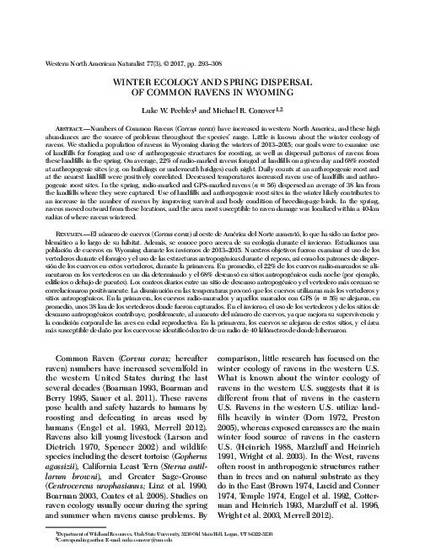
Article
Winter Ecology and Spring Dispersal of Common Ravens in Wyoming
Western North AMerican Naturalist
(2017)
Abstract
Numbers of Common Ravens (Corvus corax) have increased in western North America, and these high abundances are the source of problems throughout the species' range. Little is known about the winter ecology of ravens. We studied a population of ravens in Wyoming during the winters of 2013–2015; our goals were to examine use of landfills for foraging and use of anthropogenic structures for roosting, as well as dispersal patterns of ravens from these landfills in the spring. On average, 22% of radio-marked ravens foraged at landfills on a given day and 68% roosted at anthropogenic sites (e.g. on buildings or underneath bridges) each night. Daily counts at an anthropogenic roost and at the nearest landfill were positively correlated. Decreased temperatures increased raven use of landfills and anthropogenic roost sites. In the spring, radio-marked and GPS-marked ravens (n = 56) dispersed an average of 38 km from the landfills where they were captured. Use of landfills and anthropogenic roost sites in the winter likely contributes to an increase in the number of ravens by improving survival and body condition of breeding-age birds. In the spring, ravens moved outward from these locations, and the area most susceptible to
Disciplines
Publication Date
2017
DOI
https://doi.org/10.3398/064.077.0303
Citation Information
Michael Conover. "Winter Ecology and Spring Dispersal of Common Ravens in Wyoming" Western North AMerican Naturalist Vol. 77 Iss. 3 (2017) p. 293 - 308 Available at: http://works.bepress.com/michael-conover/57/
